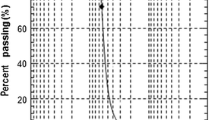Abstract
During the past earthquake, the liquefaction phenomenon of saturated sand mixture has been the cause of severe damage to various buildings and other structures. The catastrophic nature of this type of failure obliged to build a structure on geosynthetics will be used to reinforce the soil and improve its mechanical properties. Reinforcing elements in the form of layers or sheets of waste materials in soil is important because of their use in practical civil engineering and geotechnical applications. The main advantages of such materials are they are locally available, inexpensive, and recyclable. Waste plastics have been successfully used as reinforcement in soil to improve shear strength parameters and the stiffness modulus. This paper focuses on the behavior of plastic reinforcement in sand under triaxial monotonic drained conditions. Laboratory triaxial compression tests were carried out to determine stress and strain, volumetric change behavior, and shear strength parameters and to estimate the strength ratio at various strain levels in sand reinforced with plastic layers. The test involved one to five plastic layers that were placed at regular vertical spacings within the sand. The results demonstrated that the inclusion of plastic layers increases the maximum deviator stress, shear strength parameters and ductility, with the maximum increase corresponding to the five layers of plastic. The inclusion of plastic layers reduces dilation and increases the strength ratio, with the percent increase being greater at higher strain levels. The lower secant modulus was measured in the unreinforced and reinforced sand, with the latter exhibiting higher values of secant modulus at axial strains of 1 % that tend to stabilize for higher values of axial strain.












Similar content being viewed by others
References
Al-Refeai TO (1990) Laboratory tests on geotextiles reinforced dune sans. Arab J Sci Eng 15(2A):165–174
Athanasopoulos GA (1993) Effect of particle size on the mechanical behaviour of sand-geotextile composites. Geotextiles and Geomembranes 12: 255--273
Ashmawy AK, Bourdeau PL (1998) Effect of geotextile reinforcement on stress–strain and volumetric response of sand. Proceedings of the Sixth International Conference on Geosynthetics. Atlanta 2:1079–1082
Bishop AW, Henkel DJ (1969) The measurement of soil properties in the triaxial test. Wiliam Clowes and Sons Limited, London and Beccles
Consoli NC, Montardo JP, Prietto PDM, Passa GS (2002) Engineering behavior of sand reinforced with plastic waste. Geotech Geoenvironmental Eng 128(6):462–472
Dali BM (1989) Renforcement des sols par des nappes d’éléments souples et discontinus: Etude de procédé Plasterre. Thèse de doctorat, Université Lyon I
Gray DH, Al-Refeai TO (1986) Behavior of fabric fiber reinforced sand. Geotech Eng 112(8):804–820
Gray DH, Asce AM, Ohashi H (1983) Mechanics of fiber reinforcement in sand. Geotech Eng 109(3):335–353
Haeri SM, Noorzad R, Oskoorouchi AM (2000) Effect of geotextile reinforcement on the mechanical behaviour of sand. Geotext Geomembr 18:385–402
Head KH (1986) Manual of soil laboratory testing, 2. Pentech Press, London
Lade PV, Duncan JM (1973) Cubical triaxial tests on cohesionless soil. Journal of Soil Mechanics and Foundations Division ASCE, vol. 99, n° SM10:793–812
Latha MG, Murthy VS (2007) Effects of reinforcement form on the behaviour of geosynthetic reinforced sand. Geotext Geomembr 25:23–32
Messas T (1999) Caractérisation et renforcement des sols avec inclusion de nappes plastiques souples discontinues. Rev Fr Géotech 87:55–62
Michalowski RL, Cermak J (2003) Triaxial compression of sand reinforced with fibers. Geotech Geoenvironmental Eng 129(2):125–136
Moghaddas TSN, Asakereh A (2007) Strength evaluation of wet reinforced silty sand by triaxial test. International Journal of Civil Engineering 5(4):274–283
Nguyen MD, Yang KH, Lee SH, Wu CS, Tsai MH (2013) Behavior of nonwoven-geotextile-reinforced sand and mobilization of reinforcement strain under triaxial compression. Geosynth Int 20:207–225
Noorzad R, Mirmoradi SH (2010) Laboratory evaluation of the behavior of a geotextile reinforced clay. Geotext Geomembr 28:386–392
Rakotondramanitra JD (1988) Renforcement des sols par des nappes de déchets de matières plastiques. Thèse de doctorat, Université Lyon I
Richa B (1992) Etude au triaxial dynamique de liquéfaction des sols renforcés par géotextiles. Université de Joseph Fourier IRIGM-LGM, Thèse de doctorat
Vercueil D, Billet P, Cordary D (1997) Study of the liquefaction resistance of a saturated sand reinforced with geosynthetics. Soil Dyn Earthq Eng 16:417–425
Author information
Authors and Affiliations
Corresponding author
Rights and permissions
About this article
Cite this article
Nouri, S., Nechnech, A., Lamri, B. et al. Triaxial test of drained sand reinforced with plastic layers. Arab J Geosci 9, 53 (2016). https://doi.org/10.1007/s12517-015-2017-y
Received:
Accepted:
Published:
DOI: https://doi.org/10.1007/s12517-015-2017-y




